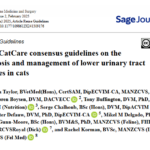scott@vtx-cpd.com
Forum Replies Created
-
AuthorPosts
-
Replying to Katherine Howie 19/05/2025 - 11:44
This is an interesting paper!
Thanks for sharing!
Scott 🙂
That’s such a good point, Kath — do you ever repeat the coccygeal blocks in hospitalised cats after the initial catheter placement? I’ve wondered if it might help in some of the really agitated ones, but haven’t used it routinely. Curious if you’ve found it helpful beyond the initial intervention.
Scott 🙂
Talking about feline lower urinary tract disease… I thought it would be worth sharing these brilliant new guidelines:
https://journals.sagepub.com/doi/10.1177/1098612X241309176
Scott 🙂
Great case Janette, really nicely managed and a good reminder of how stabilisation can completely change the outcome.
Do you tend to use calcium gluconate first line in all your hyperkalaemic cats, or more selectively based on ECG changes?
Thanks again for sharing.
Scott 🙂
Replying to Anna J. 13/05/2025 - 19:19
Anna!
Welcome. Thank you for joining us!
I really hope that you enjoy the course. 3 children would be enough for me without adding in the dog and the chickens! 🙂
Scott 🙂
Replying to Liz Bode 12/05/2025 - 21:15
I am not brave enough to say!
Scott 🙂
Replying to Jon H. 12/05/2025 - 20:48
Hey Jon.
Thank you so much for joining us and for your brilliant contribution.
My list of historical nightmares is too long to share sadly.
Scott 🙂
Replying to Raquel M. 14/05/2025 - 12:00
Hey Raquel!
Hope you are well. Charily practice? On the island? Tell us more! That sounds like an exciting change.
My favourite job to date was working for the PDSA when I first graduated.
Scott 🙂
Replying to Jane Sedgewick 14/05/2025 - 11:46
No problem!
These sorts of consensus statements are brilliant for helping creating protocols.
Cleaver people get together and do the work for us!
Scott 🙂
Replying to Rachel H. 14/05/2025 - 12:04
No problem!
Keep the questions coming!
Scott 🙂
Replying to Jane Sedgewick 14/05/2025 - 12:07
Hi Jane,
Thank you so much for the great questions. You are definitely not a pest. It’s fantastic that you’re getting so much out of the course.
You’re absolutely right that when you have a collapsed dog with marked hyperkalaemia and hyponatraemia, Addison’s becomes the top differential, especially in the presence of classic clinical signs like lethargy, vomiting, bradycardia, and hypovolaemia. Very few diseases give you that combination in a sick dog. Once sodium is low and potassium is genuinely high (not an artefact), Addison’s should be considered the most likely diagnosis unless something else clearly explains it, like urinary obstruction or acute kidney injury.
That said, regarding your question about differentials for a low basal cortisol, there are a few scenarios where this might occur without true Addison’s:
Critical illness-related corticosteroid insufficiency (CIRCI) is increasingly recognised in dogs with sepsis or SIRS. These dogs may have a flat or blunted ACTH stim but are not Addisonian. A 2021 study by Marchetti et al. found that CIRCI occurred in nearly 50% of dogs with SIRS and was associated with increased CRP and band neutrophils, but not necessarily with hypotension or mortality. Importantly, these dogs may have low delta cortisol on ACTH testing, so we need to interpret results carefully in the ICU setting.
Reference: Marchetti M, Pierini A, Favilla G, Marchetti V. Critical illness-related corticosteroid insufficiency in dogs with systemic inflammatory response syndrome: A pilot study in 21 dogs. Vet J. 2021;273:105677. doi:10.1016/j.tvjl.2021.105677
Iatrogenic suppression from prior steroid treatment, even topical creams or ear medications.
Sampling variation. Basal cortisol is highly dynamic and a low result can sometimes occur transiently in otherwise healthy or mildly stressed animals.
Hepatic dysfunction or severe systemic illness, which can affect cortisol metabolism or binding proteins.
That’s why, even in the face of compatible electrolytes and clinical signs, a low basal cortisol doesn’t confirm Addison’s. It just tells us we can’t rule it out. That’s where the ACTH stim is still essential. On the flip side, a basal cortisol above 55 nmol/L (around 2 µg/dL) is very helpful to exclude Addison’s.
The combination of all three in a collapsed dog dose make Addison’s the most likely thing! It’s questions like this that make the course better, so please do keep them coming.
Happy Sunday!
Scott 🙂
Replying to mark n. 16/05/2025 - 21:20
Hello Mark!
Welcome. Bass fishing… I might need some educating there… is that like normal fishing, just with better fish?!
Thanks for joining the course. I really hope you enjoy it.
Scott 🙂
Replying to Emma Holt 16/05/2025 - 21:52
No problem!
There is clearly some difference of opinion here! I am going to some talks on this later in the year too so will keep you updated with what the smart people (not me!) are saying!
Hope all is well with you.
Scott 🙂
Replying to Emma Holt 16/05/2025 - 21:52
No problem!
There is clearly some difference of opinion here! I am going to some talks on this later in the year too so will keep you updated with what the smart people (not me!) are saying!
Hope all is well with you.
Scott 🙂
Replying to Emma Holt 16/05/2025 - 21:52
No problem!
There is clearly some difference of opinion here! I am going to some talks on this later in the year too so will keep you updated with what the smart people (not me!) are saying!
Hope all is well with you.
Scott 🙂
-
AuthorPosts


